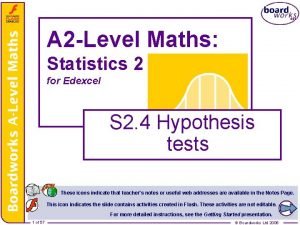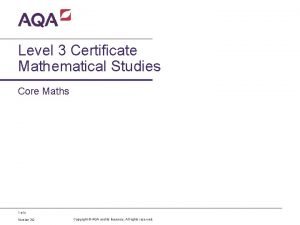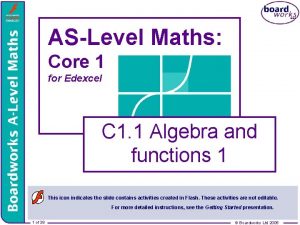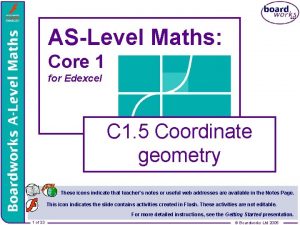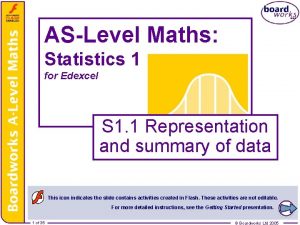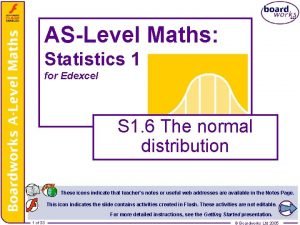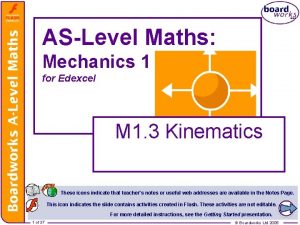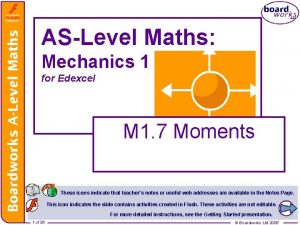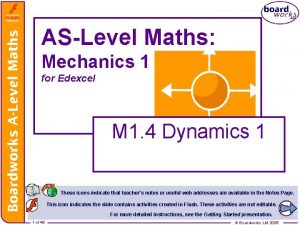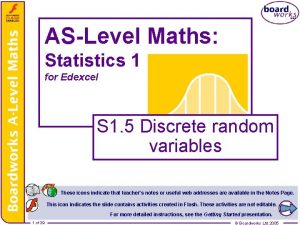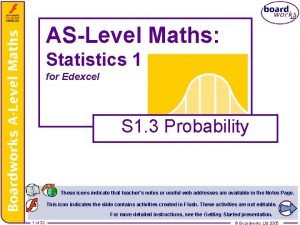ASLevel Maths Core 2 for Edexcel C 2




































- Slides: 36

AS-Level Maths: Core 2 for Edexcel C 2. 8 Integration These icons indicate that teacher’s notes or useful web addresses are available in the Notes Page. This icon indicates the slide contains activities created in Flash. These activities are not editable. For more detailed instructions, see the Getting Started presentation. 1 of 36 © Boardworks Ltd 2005

Evaluating definite integrals Contents Evaluating definite integrals The area under a curve The trapezium rule Examination-style questions 2 of 36 © Boardworks Ltd 2005

Definite and indefinite integrals When we find the indefinite integral of a function the answer takes the form of an expression plus a constant of integration. When we find a definite integral of a function we find the integral between two given limits to give a numerical result. For example, the definite integral of 6 x 2 + 5 between x = 1 and x = 3 is written as It is evaluated as follows: Notice that square brackets are used here … …and rounded brackets here. c cancels out. 3 of 36 © Boardworks Ltd 2005

Definite integration When evaluating a definite integral we can ignore constants of integration because they cancel out. In general: 4 of 36 © Boardworks Ltd 2005

The area under a curve Contents Evaluating definite integrals The area under a curve The trapezium rule Examination-style questions 5 of 36 © Boardworks Ltd 2005

The area under a velocity-time graph velocity (m/s) The following graph shows how the velocity of a car changes over a period of 40 seconds. What does the area under the graph represent? 8 Consider the area of a thin strip of the graph. 6 4 2 0 0 5 10 15 20 25 30 35 40 time (s) If the strip is thin enough it can be treated as if it is rectangular. The area of the strip = velocity × time = distance The area of each strip represents the distance travelled during a small period of time. The total area is the total distance travelled. 6 of 36 © Boardworks Ltd 2005

The area under a velocity-time graph In many situations the acceleration will not be constant and the velocity-time graph will be curved. velocity (m/s) For example, this graph shows the velocity-time graph for a car in the first 10 seconds after it moves off from rest. To find the distance travelled by the car over this time we need to find the area under the curve. 8 6 It is possible to estimate this area by dividing it into thin vertical strips and summing their areas. 4 2 0 0 7 of 36 2 4 6 8 10 time (s) However, if we know the velocity of the car as a function of time we can find the area more accurately by integration. © Boardworks Ltd 2005

The area under a curve To see why the area under a curve can be found by integration, consider a continuous curve y = f(x). Let A be the area shown between the curve y = f(x) and the x-axis from x = 0 to x. y δy A δA x 0 Now, imagine moving a small distance along the x-axis, δx. x+δx x We can call the corresponding increase in area δA and corresponding increase in y δy. Let’s look more closely at this increase in area. 8 of 36 © Boardworks Ltd 2005

The area under a curve We can see that δA must be between yδx and (y + δy)δx. We can write this as δy yδx < δA < (y + δy)δx Dividing through by δx gives y δA y + δy Now consider the limit as δx and δy → 0: δx so Integrating both sides with respect to x gives 9 of 36 © Boardworks Ltd 2005

The area function The area under a curve y = f(x) is therefore a function of x, which we can write as A(x) is the area under the curve from x = 0 to x. Look what happens when the area function y = A(x) is plotted for some function y = f(x) as x varies. 10 of 36 © Boardworks Ltd 2005

The area under a curve Suppose that we want to find the area A under a curve between two given values of x; x = a and x = b. If the area between x = 0 and b is A(b) y and the area between x = 0 and a is A(a) a In general: 11 of 36 A(b) A b x then the area A under the curve from x = a to x = b must be A = A(b) – A(a) The area A under a curve y = f(x) between the limits x = a and x = b is given by © Boardworks Ltd 2005

The area under a curve Find the area bounded by the curve y = 2 x 2 + 1, the x-axis and the lines x = – 1 and x = 3. Start by sketching the graph of y = 2 x 2 + 1 and shading the required area. y y = 2 x 2 + 1 A – 1 3 x The final solution can be written as 22 units 2. 12 of 36 © Boardworks Ltd 2005

Areas below the x-axis Suppose the area that we are trying to find is below the x-axis. For example: Find the area bounded by the curve y = x(x – 6) and the x-axis. y 0 This area is given by: y = x(x – 6) A 6 x The calculated area is negative because it is below the x-axis. We write the actual area as 36 units 2. 13 of 36 © Boardworks Ltd 2005

Areas below the x-axis In some cases the area may fall partly below the x-axis and partly above. For example: Find the area between y = 9 x – x 3 and the x-axis. Factorizing gives y y = x(3 + x)(3 – x) So the graph cuts the x-axis at x = – 3, x = 0 and x = 3. – 3 0 3 x Also, x 3 is negative so the curve is -shaped. The required area can now be shaded in. 14 of 36 © Boardworks Ltd 2005

Areas below the x-axis Look what happens if we try to find the area under y = 9 x – x 3 between – 3 and 3. From the shading on our graph we know the area isn’t 0. What has happened is that the negative area below the graph has cancelled out the positive area above the graph. To avoid this we have to find the areas above and below the x-axis separately and then add the two areas together. 15 of 36 © Boardworks Ltd 2005

Areas below the x-axis Let’s call the two areas A 1 and A 2. y A 2 – 3 A 1 0 3 x The total area = A 1 + A 2 = 40 units 2. 16 of 36 © Boardworks Ltd 2005

The area between a curve and a line Suppose we want to find the area between a curve and a line. For example: Find the area bounded by the curve y = x 2 + 1 and the line y = 2 x + 4. Start by sketching the graph, and shading the required area. Next, we have to find the x-coordinates of the points where the curve and the line intersect. y y = x 2 + 1 Solving: x 2 + 1 = 2 x + 4 y = 2 x + 4 – 1 3 x x 2 – 2 x – 3 = 0 (x +1)(x – 3) = 0 the curve and the line intersect when x = – 1 and x = 3. 17 of 36 © Boardworks Ltd 2005

The area between a curve and a line The area under the line y = 2 x + 4 between x = – 1 and x = 3 is this area: While the area under the curve y = x 2 + 1 between x = – 1 and x = 3 is this area: y y = x 2 + 1 A y = 2 x + 4 – 1 3 x So the area we require, A, can be found by subtracting the area under the curve from the area under the line. This area is given by: 18 of 36 © Boardworks Ltd 2005

The area between a curve and a line Since the limits are the same these two integrals can be combined to give So the required area is 7 units 2. 19 of 36 © Boardworks Ltd 2005

The area between two curves The method used to find the area between a curve and a line can also be used to find the area between two curves. In general: y y = f(x) The area A between two curves y = f(x) and y = g(x) is given by A a y = g(x) b x For example: Find the area bound by the curves y = 3 – 2 x 2 and x = – 1 – x 2. 20 of 36 © Boardworks Ltd 2005

The area between two curves y Start by equating the curves to find out where they intersect. y = 3 – 2 x 2 = – 1 – x 2 A x 4 – x 2 = 0 (2 – x)(2 + x) = 0 y = – 1 – x 2 Simplify the integral: 21 of 36 So the curves intersect at x = 2 and x = – 2. Find the area: © Boardworks Ltd 2005

Contents The trapezium rule Evaluating definite integrals The area under a curve The trapezium rule Examination-style questions 22 of 36 © Boardworks Ltd 2005

Approximating the area under a curve Sometimes the area under a curve cannot be found by integration. This may be because we cannot find the integral of the equation of the curve or because we need to find the area under a curve produced from experimental data. In these cases we can use a method to approximate the area under the curve. One such method is called the trapezium rule. It works by dividing the area under a curve into trapeziums and calculating their areas. Remember: The area of a trapezium = 23 of 36 a h b or b a h © Boardworks Ltd 2005

The trapezium rule To demonstrate the method consider the area under the curve y = x 2 + 1. 24 of 36 © Boardworks Ltd 2005

The trapezium rule The more trapeziums the area is divided into the more accurate the estimate. Suppose we wish to find the area under a curve y = f(x) between x = a and x = b. We can divide the area into four trapeziums of y equal width h. y 0 y 1 h a y 2 h y 4 y 3 h h b x The parallel sides of the four trapeziums are given by the five ordinates y 0, y 1, y 2, y 3 and y 4. In general, if there are n trapeziums there will be n + 1 ordinates. 25 of 36 © Boardworks Ltd 2005

The trapezium rule The approximate area using the trapezium rule is: The ordinates have to be spaced out evenly so that the width of the trapeziums are the same. for n trapeziums of equal width h: In general, the trapezium rule with n trapeziums is: 26 of 36 © Boardworks Ltd 2005

The trapezium rule Use the trapezium rule with four trapeziums to estimate the value of State whether this is an overestimate or an underestimate of the actual area. The width h of each trapezium = We can use a table to record the value of each ordinate. x 27 of 36 1 1. 25 1 0. 8 y 0 y 1 1. 5 1. 75 0. 667 0. 571 y 2 y 3 2 0. 5 y 4 © Boardworks Ltd 2005

The trapezium rule We can now work out the area using with h = 0. 25 and the ordinates given by the table, so: = 0. 70 (to 2 d. p. ) We can show whether this is an underestimate or an overestimate by sketching the area given by the trapezium rule on the graph of 28 of 36 © Boardworks Ltd 2005

The trapezium rule y 1 2 x We can see from this sketch that the approximation given by the trapezium rule is a slight overestimate of the actual area. 29 of 36 © Boardworks Ltd 2005

Overestimates and underestimates In general, when the gradient of the graph is increasing over the given interval the area given by the trapezium rule will be an overestimate of the actual area. When the gradient of the graph is decreasing over the given interval the area given by the trapezium rule will be an underestimate of the actual area. 30 of 36 © Boardworks Ltd 2005

Contents The trapezium rule Evaluating definite integrals The area under a curve The trapezium rule Examination-style questions 31 of 36 © Boardworks Ltd 2005

Examination-style question 1 The following diagram shows the curve with equation = x 2 – 4 x + 5 and the line y = 8 – 2 x. The line and the curve intersect at the points A and B. y a) Find the coordinates of A and B. b) Find the area of the shaded region R. A R B x 32 of 36 © Boardworks Ltd 2005 y

Examination-style question 1 a) Equating the given equations: x 2 – 4 x + 5 = 8 – 2 x x 2 – 2 x – 3 = 0 (x + 1)(x – 3) = 0 x = – 1 or x = 3 When x = – 1, y = 10 and when x = 3, y = 2. The coordinates of A are (– 1, 10) and the coordinates of B are (3, 2). b) The area of R is given by 33 of 36 © Boardworks Ltd 2005

Examination-style question 1 Combining these gives So the required area is 7 units 2. 34 of 36 © Boardworks Ltd 2005

Examination-style question 2 a) Use the trapezium rule with 4 ordinates to estimate to 2 decimal places the value of b) State whether the estimate given in part a) is an overestimate or underestimate of the area under the curve y = tan x between x = 0 and x =. The width h of each trapezium = Using a table to record the value of each ordinate: x 0 y = tan x 0 35 of 36 0. 364 0. 839 1. 732 © Boardworks Ltd 2005

Examination-style question 2 We can now work out the area using with h = and the ordinates given by the table, so: = 0. 72 (to 2 d. p. ) b) Sketching the curve y = tan x shows that the value given in a) is a slight overestimate of the actual area. y 0 36 of 36 x © Boardworks Ltd 2005
 Hypothesis testing a level maths
Hypothesis testing a level maths Maths gcse question
Maths gcse question Fermi estimation core maths
Fermi estimation core maths Core 4 maths
Core 4 maths The brittle, rocky outer layer of earth
The brittle, rocky outer layer of earth Inner core and outer core
Inner core and outer core Basic layers of the earth
Basic layers of the earth Core rigidity
Core rigidity Sju för caesar
Sju för caesar Tack för att ni lyssnade bild
Tack för att ni lyssnade bild Strategi för svensk viltförvaltning
Strategi för svensk viltförvaltning Ledningssystem för verksamhetsinformation
Ledningssystem för verksamhetsinformation Tack för att ni har lyssnat
Tack för att ni har lyssnat Ekologiskt fotavtryck
Ekologiskt fotavtryck Centrum för kunskap och säkerhet
Centrum för kunskap och säkerhet Läkarutlåtande för livränta
Läkarutlåtande för livränta Påbyggnader för flakfordon
Påbyggnader för flakfordon Inköpsprocessen steg för steg
Inköpsprocessen steg för steg Anatomi organ reproduksi
Anatomi organ reproduksi Egg för emanuel
Egg för emanuel Atmosfr
Atmosfr Relativ standardavvikelse formel
Relativ standardavvikelse formel Rutin för avvikelsehantering
Rutin för avvikelsehantering Fspos
Fspos Klassificeringsstruktur för kommunala verksamheter
Klassificeringsstruktur för kommunala verksamheter Myndigheten för delaktighet
Myndigheten för delaktighet Presentera för publik crossboss
Presentera för publik crossboss Kung dog 1611
Kung dog 1611 Tack för att ni lyssnade
Tack för att ni lyssnade Debattinlägg mall
Debattinlägg mall Tobinskatten för och nackdelar
Tobinskatten för och nackdelar Vad är referatmarkeringar
Vad är referatmarkeringar Punkthöjd karttecken
Punkthöjd karttecken Biologiska arvet
Biologiska arvet Shingelfrisyren
Shingelfrisyren Programskede byggprocessen
Programskede byggprocessen Rådet för byggkompetens
Rådet för byggkompetens
